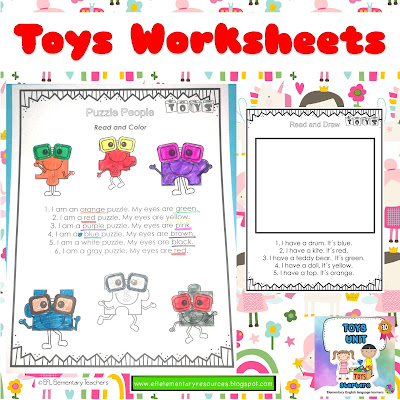This resource is included in Toys Unit for Elementary English Language learners-Starters found at this LINK: https://www.teacherspayteachers.com/Product/Toys-unit-for-Elementary-English-Language-Learners-Starters-1865563
A resource for any English Teacher in the Primary Classroom.
Worksheets can be used for differentiationand provide extra practice. Tailor to meet the needs of each student in class with this variety of worksheets. The worksheets can challenge and support all your learners during your practice part of the lesson plan.
More repetition as students write all the words into the letter shapes that the words start with. This process enhances comprehension and reinforcement of vocabulary retention. Send it for homework.
Read and match worksheet. Basically, a
reading comprehension worksheet to exercise critical thinking to analyze the incomplete
words and make a connection.
Use this set of worksheets to establish
a connection between the spoken and written Language.
Use
the word search worksheet for the practice of recognizing toy names in a sea of
letters, which reinforces visual recognition of vocabulary words. Learners will
scan for the toys words as a way to enhance the students’ focus and attention
to detail.
Worksheets for the students to
complete sentences by filling in the blanks with the correct toy name. Find
worksheets to practice forming and answering questions about toys.
Read-and-color worksheets often use
simple sentences, which help ELLs practice reading comprehension. They need to
understand what they read in order to color the correct items. These will promote higher thinking skills in
your learners.
Expand the worksheet to other themes.
Have the students cut the teddy bear and glue onto their notebooks or paper and
label the parts of the face.
Check this blog post with more on the
robot family: https://eflpreschoolteachers.blogspot.com/2020/10/family-theme-for-kindergarten-holistic_19.html
By relating toys to a house setting,
students can see how vocabulary and language structures are used in everyday
contexts, as they draw the toys in the rooms of the house.
The face and toys worksheets include
activities like matching, answering, and coloring to cater to kinesthetic
learners who benefit from hands-on activities.
Associating the colors written word
with an image can serve as a memory aid.
There are several worksheets for answering questions using grammar knowledge.
Students: two!
Do you love
graphing? Get more worksheets for other themes: https://www.teacherspayteachers.com/Product/Graphing-Worksheets-for-Elementary-English-Language-Learners-11309998
English Questionnaires are a very
effective instructional tools to have your students communicate. Encourage them to survey classmates even the shy ones.
This resource has more to check, go to this blog post: https://eflelementaryresources.blogspot.com/2024/05/toys-unit-robots-for-elementary-english.html
Find more activities
and resources for the toys unit at my other blog.
www.eflpreschoolteachers.blogspot.com



















































